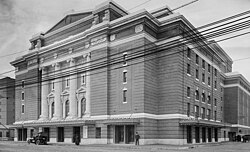Boston Opera House (1909)
| Boston Opera House | |
|---|---|
 The Boston Opera House, c. 1910 | |
 | |
| General information | |
| Type | Opera house |
| Address | Huntington Avenue |
| Town or city | Boston, Massachusetts |
| Country | United States |
| Coordinates | 42°20′26″N 71°05′23″W / 42.3405°N 71.0896°W |
| Opened | November 8, 1909 |
| Demolished | 1958 |
| Owner | Boston Opera Company |
| Design and construction | |
| Architecture firm | Wheelwright and Haven |
The Boston Opera House was an
Speare Hall, a Northeastern University dormitory, now stands on the site at the corner of Opera Place and Huntington Avenue.[1]
History

Construction
Designed by the Boston architects
Opening
The opera house officially opened on November 8, 1909 with a performance of La Gioconda by the BOC. The production starred Lillian Nordica in the title role, Florencio Constantino as Enzo, and Louise Homer as La Cieca.[1] At its opening, the theatre was described as a "perfect jewel-box of an opera house". It served as the home of the BOC during the company's six years of operation. Russell served as the company's director for all its short duration and Arnaldo Conti was the conductor from 1909–1913. After the BOC went bankrupt in 1915 the venue was used by other local opera companies, as well as by the Metropolitan Opera for its regular visits.
Demise
During the Great Depression and World War II, the Opera House fell into disuse and disrepair.[1]
In 1957, the
"It was the era of urban renewal," Boston impresario Walter Pierce was quoted as saying, "Anything old was shameful."[3]
A brick rescued from the demolished theater by noted WGBH-FM announcer Ron Della Chiesa is preserved in the theater's archives at Northeastern University. The archived plans for the Opera House may be viewed and copied by requesting an appointment with Northeastern University's Facilities or Space Planning and Design Department.
See also
- Boston Opera House (1980)
References
- ^ a b c Opera House History Archived August 7, 2008, at the Wayback Machine
- ^ "Boston's Final Curtain". Time Magazine, Volume 70, Issue 12, p. 78. September 16, 1957.
- ^ Larson, Susan (1996). "Homeless in Boston". Opera News, Vol. 61, Issue 3.
Further reading
- A list of books on the operas announced for production at the Boston Opera House during the season of MCMXI-MCMXII in the Public Library of the city of Boston, Boston: Boston Public Library, pub by the trustees, 1911, OL 24360461M
- Henry Charles Lahee. The grand opera singers of to-day: an account of the leading operatic stars who have sung during recent years, together with a sketch of the chief operatic enterprises. Boston: L.C. Page and Company, 1912
External links
- Eichler, Jeremy, "The rise and fall of the original Boston Opera House", The Boston Globe, November 8, 2009.
- Program for 1910 productions on New York Public Library website nypl.org
- Program for 1910 productions on New York Public Library website nypl.org
- Program for 1920 productions on New York Public Library website nypl.org
- Postcard on New York Public Library website nypl.org
- Aerial photo of Boston Opera House and vicinity, 1950s on Flickr.com
